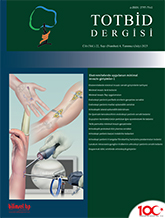
De Quervain`s disease (tenosynovitis) presents as impingement syndrome due to tenosynovitis of the abductor pollicis longus (APL) and extensor pollicis brevis (EPB) tendons in the first extensor compartment. It is a common disorder with a prevalence of 0,5% in men and 1,3% in women. Patients usually feel pain over the radial styloid and this pain increases especially with thumb movements. They feel pain when lifting and grasping objects with the wrist in a neutral position. De Quervain is often a self-limited disease. Most patients are relieved by non-surgical methods. These methods are; rest, non-steroidal anti-inflammatory drugs, splinting, physical therapy modalities, steroid injections into the tendon sheath. It is recommended to release the first extensor compartment in resistant cases that do not respond to non-surgical treatments. This release can be done openly or endoscopically. Various complications related to surgery can also be seen. These are cephalic vein injury, radial nerve sensory branch injury, tendon subluxations, painful wound scar tissue and wound problems. Iatrogenic radial nerve sensory branch injury is also among the common complications. In order to reduce these complications, which are more common in open surgery, release surgery is performed with the endoscopic method. After the surgery performed with the endoscopic method, there is less pain in the early period and more patient satisfaction due to the smaller wound area.